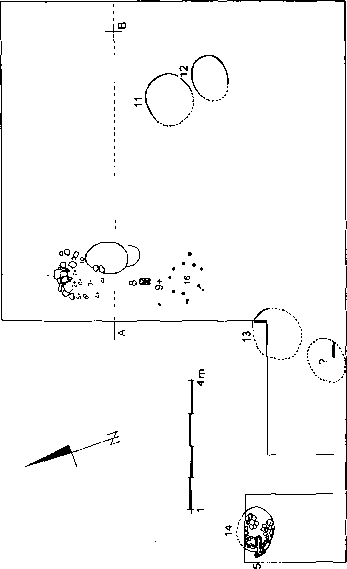image065


Fig. 52. Płock. The alleged pagan sanctuary, excavation site 3 (in Ihe abbey yard), layer V. 1 - a stone altar; 2-a skuli; 3-a club 4-aphallic object; 5—7 - day vessds; 8-apole; 9 - a vessel with traces of iron melting; 10-13 - fires; 14 -astcmefire-place; 15 - a horse head; 16 — i After W. Szafrański, 1983, p. 143
7. Ruthenian sanctuaries
Primary Russian Chronicie (PSRL, vol. 1, 1926, p. 9) recorded the follow-ing myth about the origins of Kiev: “There were three brothers: one was called Kiy, the other Shchek and the third Khoriv, and their sister was called Lybedz. Kiy sat at the mountain where now the Borychevsky entrance is situated, Shchek at the mountain now called Shchekovitsa, and Khoriv at another mountain, named Khorivitsa after him. And they founded a strong-hold in the name of their eldest brother and named it Kiev (...). They were wise and cautious men, they were called Polanians, after them the Polanians have lived in Kiev until today.” The original version of Primary Chronicie, preserved in the First Novgorod Chronicie, contained a further fragment: “they were pagans, they madę offerings to lakes, springs and forests, like other pagans.” The stronghold of Kiy, the mythical father of Ruthenian Polanians, appears in the myth as the centre of their domain. It is confirmed by another legend from Primary Chronicie, conceming Apostle Andrew, who allegedly erected a cross on the Kiev Mountain.
The text of the chronicie is set in a cultural context. The described place functioned as a sanctuary, as exactly over the entrance mentioned in the legend, Perun’s shrine was situated. Primary Chronicie first refers to it under the year 945, but the narrated events happened a year earlier, when prince Igor Rurikovich, having accepted a ransom, concluded a peace treaty with the Byzantine emperor. The text of the treaty, included into the chronicie, had been negotiated by Ruthenian envoys in Constantinopole. The treaty was ratifled in Kiev in the presence of the Emperor’s representatives (SSS, vol. 6, p. 130-135). On the day after their arrival, “Igor summoned the envoys and went to the hill where Perun stood, and they put their weapons there, their shields and gold, and Igor and his people - as many pagan Ruthenians as there were - swore the peace, while the Christians swore in St Elijah church, which is upon the stream... (PSRL, vol. 1, 1926, p. 54). The act of swearing is illustrated on a miniaturę from the fifteenth-century Radivillovskaya letopis (1902, 26v, cf. 16r, 45r), in which Perun is shown with a lightning in his hand (Khrenetsov, 1981). The text seems reliable, in spite of the doubts expressed by some researchers. The oath was included in the text of the treaty, copied to the chronicie probably from the Greek original.
133
Wyszukiwarka
Podobne podstrony:
image038 Fig. 17. Szczecin. The town arrangement in the earlier MiddJe Ages. 1 - the stronghold at t
image043 Fig. 20, Wolin. The second tempie. A - the tempie, B - the yard, C - the stable, D - the pa
image001 AV0N/8an/McVaultof the Ages Poul Anderson For owo/ in o timo wo’ll novor know, o barbarie w
essent?rving?15 Fig 10.16 The smali beech bowl being held in a caruers chops with a bar across its m
image090 Fig. 73. The alleged sanctuary on Bogit mountain. The stronghold. The cult circle. The alle
image023 Fig. 15. Korzenica-Garz. I, II, m - the alleged traces of temples in the stronghold; after
image055 Fig. 39. Starigard (Oldenburg). The sanctuary erected after the destruction of the church i
image064 Fig. 49. The alleged cult circle at Parsteiner lakę near Pehlitz. K - the drcle; R - ruins
image078 Fig. 66. The sanctuary in Rzhavintse. Top: a plan of the stronghold with sounding excavatio
image038 a Fig 10 Idea of the “World tree" as the “World axis" implemented m settlements o
image083 Fig. 67. The enthroning ceremony of a Carinthian prince on an engraving from Osłerreichisch
image089 Fig- 71. The stoi»e walls around the peak of Góra Dobrzeszowska. 1 - the internal wali; 2 -
image094 Fig. 75. The Krak Mound near Cracow. Photo L. Słupecki. is banished, and as the małe linę i
image007 Fig. 3. Old Uppsala. Alteged traces of the tempie under the church foundations; from F. Oel
image008 Fig. 4. Possible reconstructions of the tempie in Old Uppsala, drawings based cm: A.-C. Sch
image017 Fig. 10. The plan of the stronghold m Arcona reconstructed by H.Berlekamp and J.Herrmann. A
image031 Throughout a century RadogoSć was the most important sanctuary in Polabia. According to Thi
image042 Fig. 18. The topography of the early-raedjevaj Wolin. A - the presumed location of the temp
więcej podobnych podstron